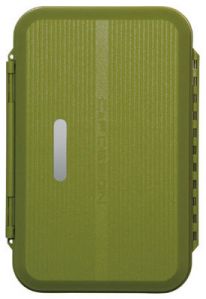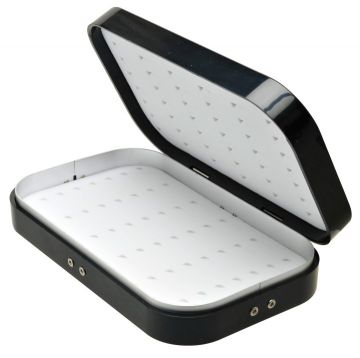Fly Box Wars
 Every angler has one thing he’ll always need, regardless of how minimalist he may be: he has to have somewhere to store his flies. Frugal types like Altoid tins and Morell foam boxes, while traditionalists prefer Wheatleys and technogeeks like the Japanese C&F Design plastic models (pictured, left). While it’s true that ultimately a fly box is just somewhere to put flies, that’s like saying a reel just stores line–it’s not the whole story.
Every angler has one thing he’ll always need, regardless of how minimalist he may be: he has to have somewhere to store his flies. Frugal types like Altoid tins and Morell foam boxes, while traditionalists prefer Wheatleys and technogeeks like the Japanese C&F Design plastic models (pictured, left). While it’s true that ultimately a fly box is just somewhere to put flies, that’s like saying a reel just stores line–it’s not the whole story.
The number one thing a fly box should do well is protect its contents; around water, that usually means keeping away the rust. Classic boxes like the Richard Wheatley hinged series (some of which are more than 100 years old) look absolutely great (pictured, below right), but they’re poor at water protection. Dunk a Wheatley, and you better get everything out to dry, or pretty soon all your hooks will crumble to brown dust (I speak from long experience). Cheapo plastic Planos also have a rust problem, not to mention that if you slip and fall on one, it’ll shatter (guilty)! Metal Wheatleys also can crumple like tin cans if you fall or sit on them, but they at least have the advantage of being able to be more or less hammered back into shape. Meanwhile, Morell foam boxes are light, cheap, and have ingenious magnetic closures; unfortunately they also are prone to crushage, even in normal carrying conditions, and they have no water barrier whatsoever.
 The absolute best boxes on the market at waterproofedness, crush protection, and organization are the C&F Design waterproof series. Their slit foam is just awesome, because the foam lasts so much longer without hooks being constantly ripped out (just witness how many have copied the technique); the systems are innovative, with swappable panels on some models, and the waterproofing works great so long as you make sure no stray hackles cross the rubber gasket barrier. Unfortunately, they are really expensive. Scientific Anglers came out with an innovative partial solution a couple years back: the System X box (pictured, below left), which relies on the old Tupperware “burp” method to ensure waterproofedness. With similar slit foam, multiple models, hinged replaceable panels, and reasonable crush protection, these are a strong alternative to the C&F Design models. The only downside is a tendency to come “un-burped” in storage (or with temperature change), and a generally cheaper build (which is both a plus and a minus).
The absolute best boxes on the market at waterproofedness, crush protection, and organization are the C&F Design waterproof series. Their slit foam is just awesome, because the foam lasts so much longer without hooks being constantly ripped out (just witness how many have copied the technique); the systems are innovative, with swappable panels on some models, and the waterproofing works great so long as you make sure no stray hackles cross the rubber gasket barrier. Unfortunately, they are really expensive. Scientific Anglers came out with an innovative partial solution a couple years back: the System X box (pictured, below left), which relies on the old Tupperware “burp” method to ensure waterproofedness. With similar slit foam, multiple models, hinged replaceable panels, and reasonable crush protection, these are a strong alternative to the C&F Design models. The only downside is a tendency to come “un-burped” in storage (or with temperature change), and a generally cheaper build (which is both a plus and a minus).
 For my own fishing, I’ve bit the bullet and use C&F Design boxes for most of my flies. My Atlantic Salmon patterns (many of them just for show) still reside in a clip-based Wheatley. My biggest beef with C&F Design is their lack of a truly big fly box; even if the sucker cost $100, I’d be interested, especially if it came with swappable panels. For my biggest flies, I’m using a Cliff Bugger Beast instead (honestly, and not to sugar-coat it, it’s nothing more than a screwdriver box with hand-slit foam glued in, but it’s the best on the market for big flies).
For my own fishing, I’ve bit the bullet and use C&F Design boxes for most of my flies. My Atlantic Salmon patterns (many of them just for show) still reside in a clip-based Wheatley. My biggest beef with C&F Design is their lack of a truly big fly box; even if the sucker cost $100, I’d be interested, especially if it came with swappable panels. For my biggest flies, I’m using a Cliff Bugger Beast instead (honestly, and not to sugar-coat it, it’s nothing more than a screwdriver box with hand-slit foam glued in, but it’s the best on the market for big flies).
Fly boxes are one of those areas where you think everything possible has already been done, then someone comes along with a hot new invention that makes you say, ‘Why didn’t I think of that.’ While the most feature-laden models are very expensive, generally speaking this is an area where you can save money by spending more up front. After all, no box is worth more than all those flies it contains – if those crumble to dust, you might as well have carried them in a paper bag.
Have a favorite fly box or an innovative fly storage solution? Let us know in the comments section!
Cloudveil Hellroaring Jacket
Affordable St. Croix, Sage Rods Reviewed











